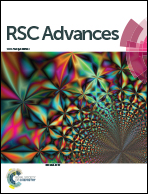Synthesis of copolymer derived from tamarind kernel polysaccharide (TKP) and poly(methacrylic acid) via SI-ATRP with enhanced pH triggered dye removal†
Abstract
A novel copolymer derived from tamarind kernel polysaccharide (TKP) and poly(methacrylic) acid (g-TKP/pMA) has been successfully synthesised through surface initiated atom transfer radical polymerization (SI-ATRP). The TKP surface has been modified by incorporating 2-bromo-2-methyl propionyl bromide (TKP-Br macroinitiator), followed by polymerization of methacrylic acid using CuBr/bpy catalyst at 65 °C. The copolymer has been characterized through FTIR and 1H NMR spectroscopy, CHN, TGA and GPC analyses. Surface morphology of the copolymer has been explored using FESEM, elemental mapping and AFM analyses. The Gelling properties of g-TKP/pMA have been studied by determining the rheological parameters. The effect of monomer/catalyst concentrations as well as temperature on the polymerization reaction has been studied as well. The pH responsive nature of the copolymer exhibits selectivity towards toxic cationic as well as anionic dyes with excellent adsorption capacity.


 Please wait while we load your content...
Please wait while we load your content...